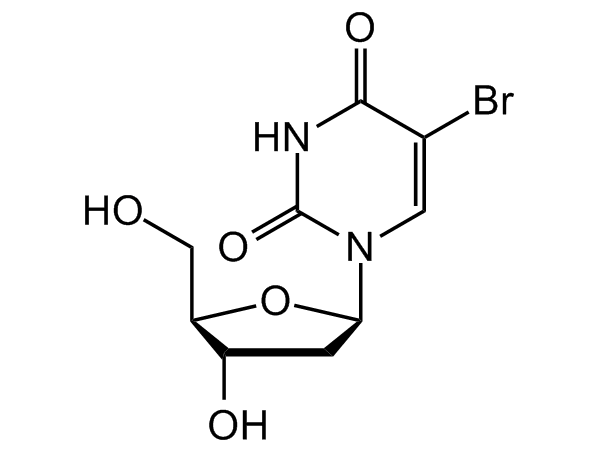
Chemical Structure
5-Bromo-2-deoxyuridine
CDX-B0301
CAS Number59-14-3
Product group Chemicals
Estimated Purity>99%
Molecular Weight307.1
Overview
- SupplierChemodex
- Product Name5-Bromo-2-deoxyuridine
- Delivery Days Customer10
- CAS Number59-14-3
- CertificationResearch Use Only
- Estimated Purity>99%
- Hazard InformationDanger
- Molecular FormulaC9H11BrN2O5
- Molecular Weight307.1
- Scientific DescriptionChemical. CAS: 59-14-3. Formula: C9H11BrN2O5. MW: 307.1. The synthetic nucleoside 5-Bromo-2-deoxyuridine (BrdU) is a thymidine analog used to label DNA and commonly used in the detection of proliferating cells in living tissues. It can be incorporated into newly synthesized DNA in place of thymidine during the S phase of the cell cycle. Cells that were actively proliferating can then be detected by denaturing the DNA and allowing specific antibodies with fluorescent tags to target the BrdU incorporation for detection via flow cytometry or fluorescence microscopy. Binding of the antibody requires denaturation of the DNA, usually by exposing the cells to acid or heat. BrdU is also used as a mutagen in genetic research. BrdU stimulates cellular differentiation and maturation in leukemia cell lines, while it inhibits differentiation of friend erythroleukemia cells. BrdU replaces Oct-4 in transcription factor-mediated reprogramming of somatic cells and can be used in small molecule cocktail to generate ciPSCs. - The synthetic nucleoside 5-Bromo-2-deoxyuridine (BrdU) is a thymidine analog used to label DNA and commonly used in the detection of proliferating cells in living tissues. It can be incorporated into newly synthesized DNA in place of thymidine during the S phase of the cell cycle. Cells that were actively proliferating can then be detected by denaturing the DNA and allowing specific antibodies with fluorescent tags to target the BrdU incorporation for detection via flow cytometry or fluorescence microscopy. Binding of the antibody requires denaturation of the DNA, usually by exposing the cells to acid or heat. BrdU is also used as a mutagen in genetic research. BrdU stimulates cellular differentiation and maturation in leukemia cell lines, while it inhibits differentiation of friend erythroleukemia cells. BrdU replaces Oct-4 in transcription factor-mediated reprogramming of somatic cells and can be used in small molecule cocktail to generate ciPSCs.
- SMILESO[C@H]1C[C@H](N2C=C(Br)C(NC2=O)=O)O[C@@H]1CO
- Storage Instruction-20°C,2°C to 8°C
- UNSPSC12352200


![5-BrdU [59-14-3]](https://www.targetmol.com/group3/M00/03/86/CgoaEWY7TrWEPWYAAAAAAGy-udI007.png)